Pronounciation of ‘piazza’: pee·at·suh
Many towns and cities throughout Europe will have an open square or public gathering area – in Italy this is known as ‘la piazza’ – the square. Many of these piazzas will have wonderful statues and fountains as well as being surrounded by some stunning architecture.
Walking is the only way to get around and explore the piazzas. There are many more piazzas in Rome than I have mentioned here, but these are must-sees. On this occasion we begin at Piazza di Trevi and finish at Piazza di Spagna; visiting Piazza della Rotonda, Piazza Navona and Piazza del Popolo along the way. There is a map at the end of this story.
Naturally, the path you take will depend on where you are staying in Rome. Visit the piazzas early in the morning to avoid the increasing crowds of tourists as the day progresses.
Piazza di Trevi
The famous Fontana di Trevi (Trevi Fountain), possibly the most famous fountain in the world, is located in this busy and picturesque piazza. The fountain from the 18th century is Rome’s largest baroque style fountain. The small Piazza di Trevi is packed with tourists who want to see just that. An endless stream of tourists hoping to make a wish or take a selfie.

The Chiesa dei Santi Vincenzo e Anastasio (Church of Saints Vincent and Anastasio) stands in front of the famous fountain and has one of Rome’s most beautiful baroque facades. It is famous for housing the praecordia, the internal organs removed when a pope is embalmed. The church houses the organs of 23 different popes. There are no notable works of art to be found here.

The piazza also houses a number of hotels, as well as several small shops and souvenir stalls, cafés, and tempting gelaterie. A pleasant place to spend some time.
The action is all over Piazza di Trevi. This small piazza is a non-stop photo opportunity from early morning until late at night. If you want peace and quiet, come early in the morning.

Piazza della Rotonda
630 metres – 7 minutes from Piazza di Trevi
The piazza directly outside the entrance to the Pantheon is known as Piazza della Rotonda. A smaller piazza than the others, it is dominated by the enormous Pantheon.
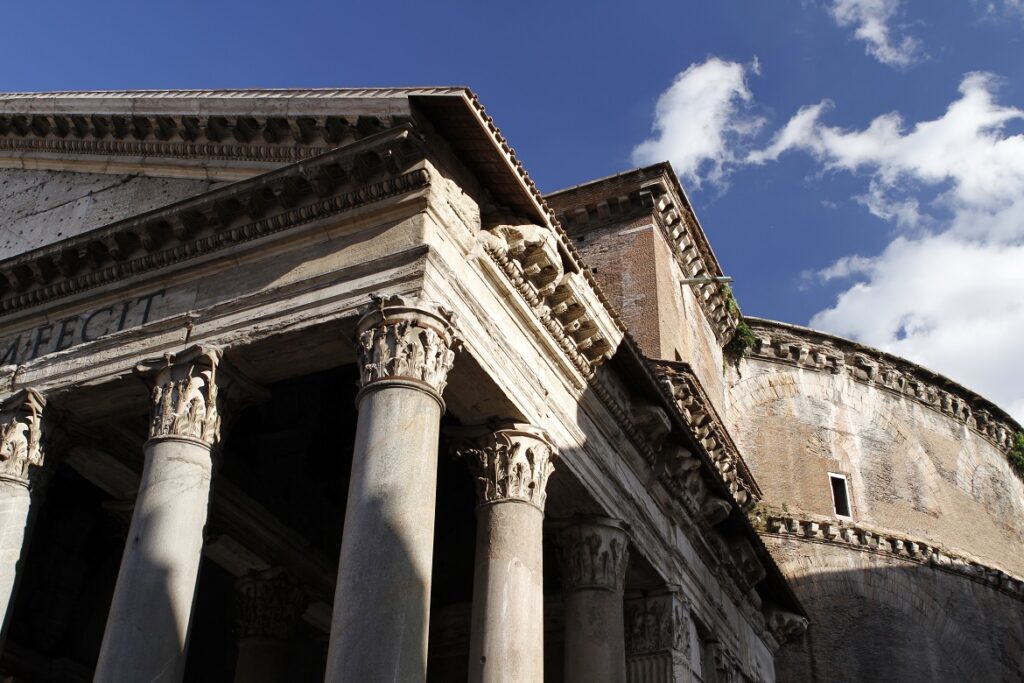
The piazza gets its name from the Pantheon’s informal name, the Chiesa di Santa Maria della Rotonda. This amazing church is a must-see while in Rome and is made much more amazing by the hole in its roof.
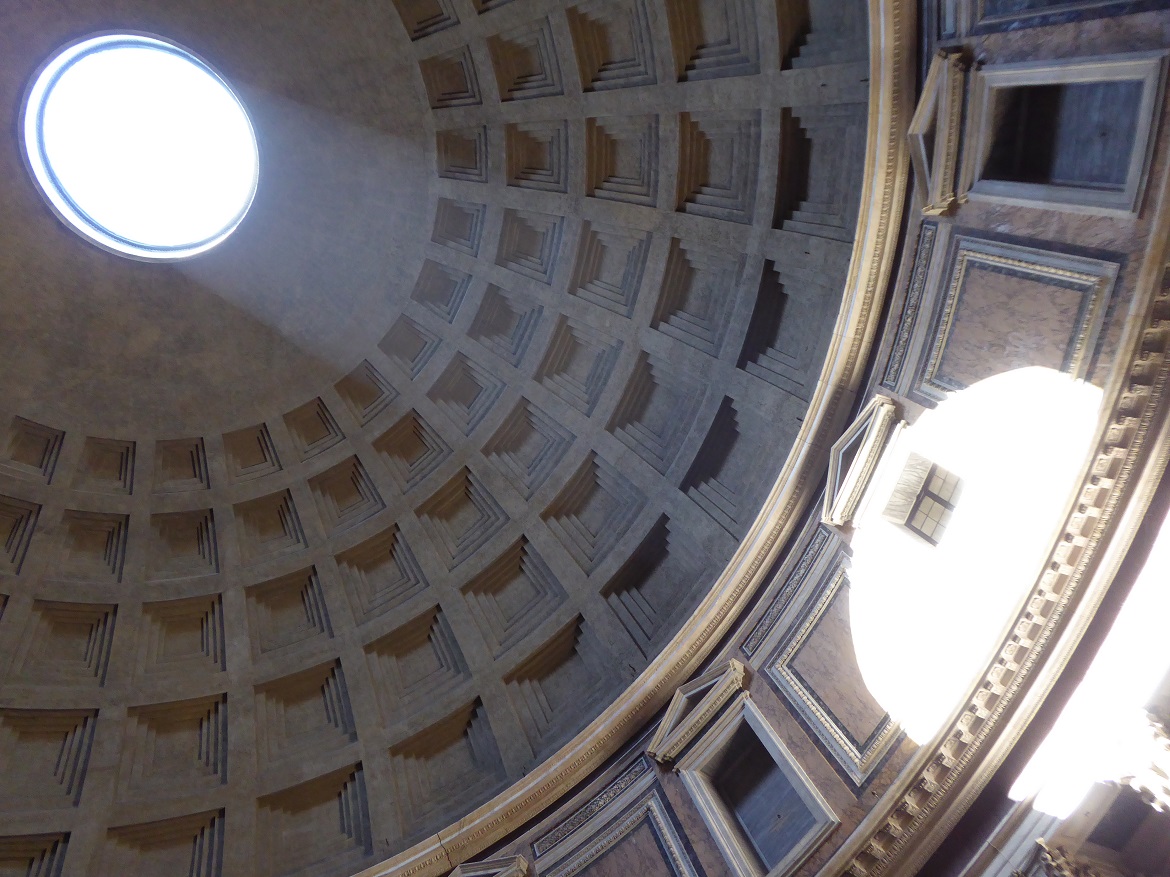
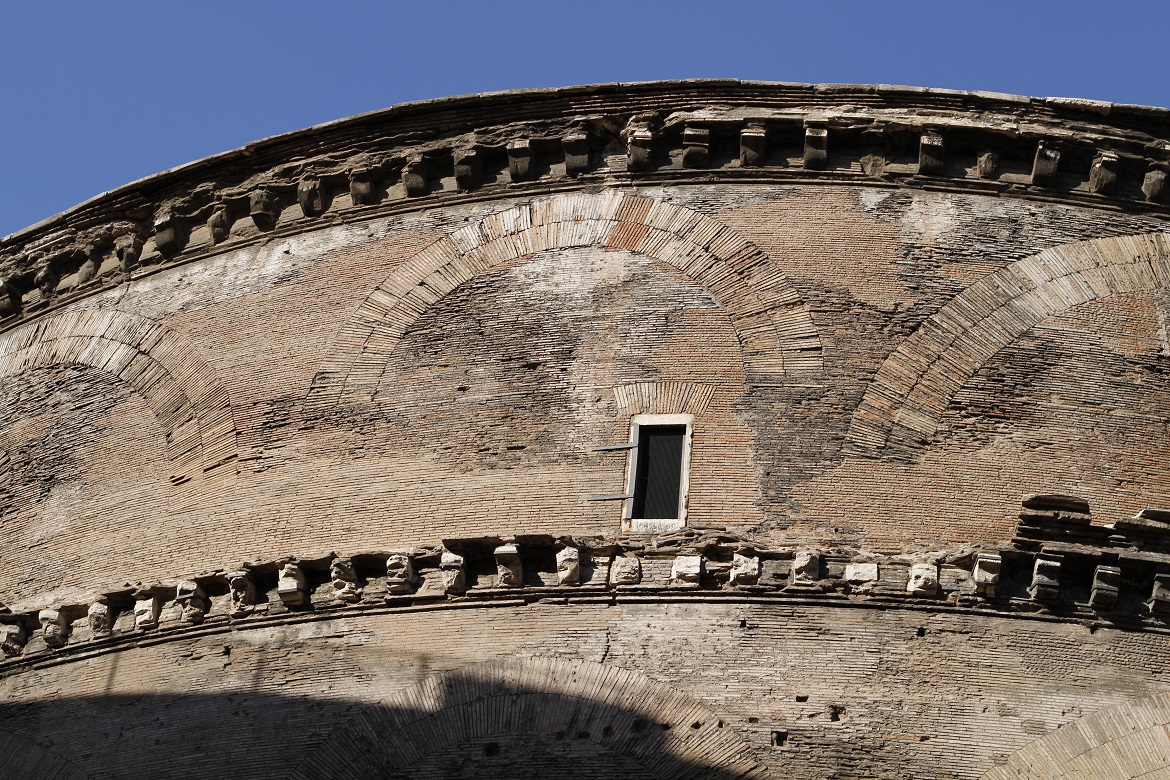
The Fontana del Pantheon (Fountain of the Pantheon) is also located here, directly in front of the Pantheon. It was designed by Giacomo Della Porta and sculpted out of marble by Leonardo Sormani. Use this fountain to create some interesting photos.
Numerous cafés may be found on the piazza itself, making it the ideal location for a bite to eat or drink.


Piazza Navona
358 metres – 4 minutes from Piazza della Rotonda
With its distinctive oval shape, Piazza Navona is one of the most attractive piazzas in the heart of Rome. Its original purpose in ancient Rome was as a stadium for athletic competitions.
Today the piazza has a lively feel and is surrounded by a large number of cafés, street performers, and musicians, all of whom add to the scene’s lively atmosphere.

There are three notable fountains along the piazza’s centre:
- Fontana dei Quattro Fiumi – (Fountain of the Four Rivers) – designed by Bernini in 1651
- Fontana del Moro – (Fountain of the Moor) – Sculpted by Giacomo della Porta
- Fontana di Nettuno – (Fountain of Neptune) – Also sculpted by Giacomo della Porta
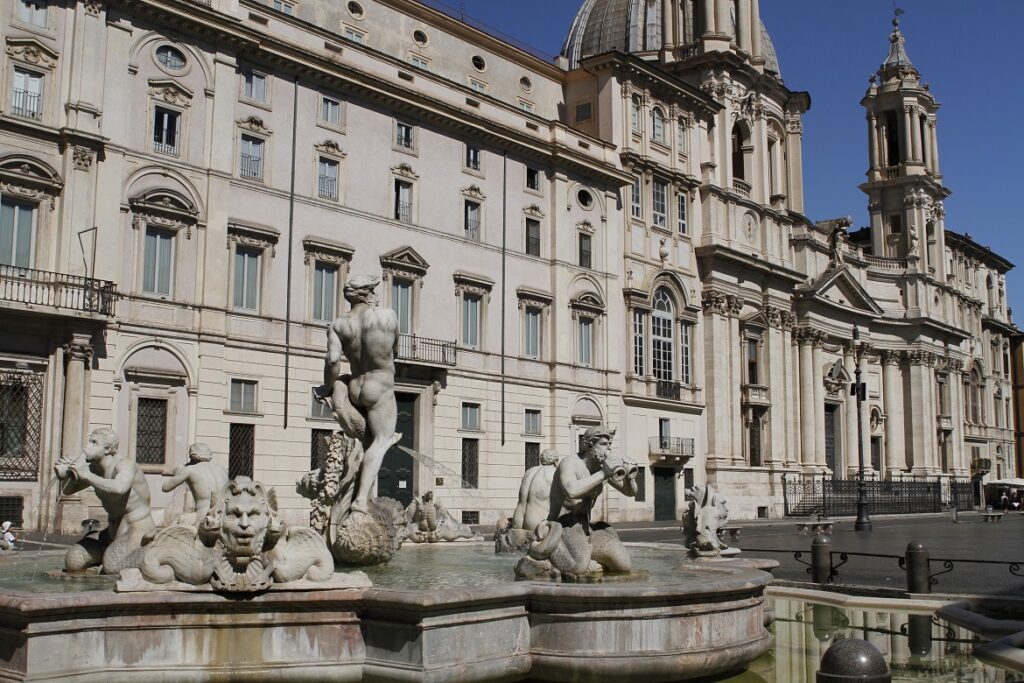


There are also two imposing buildings that face the piazza:
- Chiesa di Sant’Agnese in Agone
- Baroque style Palazzo Pamphilj
The number of tourists that gather around the Fontana dei Quattro Fiumi suggests that it is the most visited feature in the piazza.
It is a very elegant (pretty) showcase piazza in the heart of Rome, a photographer’s dream! It is also my personal favourite. Make sure you try the gelati from GROM, located at the northern point of the piazza, at the start of Via Agonale.
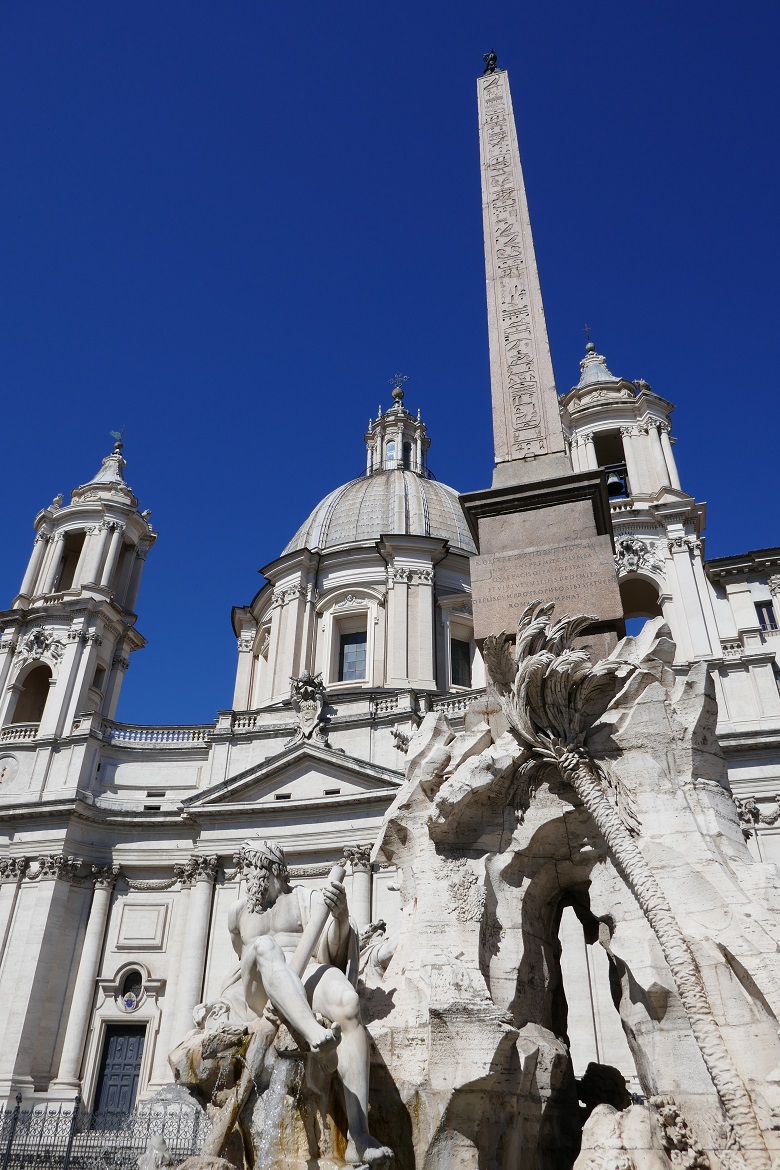
Piazza del Popolo
1.47 kilometres – 18 minutes from Piazza Navona

This is one of the most well-known piazzas in Rome. It was the main entrance to the city in ancient times, with its old impressive city gate into Rome, Porta del Popolo, located to the north of the piazza.

It is a large oval space with several interesting churches, a large obelisk, and three fountains.
The Basilica Parrocchiale Santa Maria del Popolo (Parish Basilica of Santa Maria del Popolo) is the church next to the city gate. One of the main reasons we included this piazza on our itinerary was to see this basilica, which contains two magnificent Caravaggio paintings. Caravaggio’s The Conversion of St. Paul and The Crucifixion of St. Peter can be found in the Cerasi Chapel.
The basilica is also filled with tombs and creepy skeletons. Tombs appear to be crammed into every available space.
The entrance to the church has a notable funerary monument that is sure to catch your eye. To the left is a rather eerie funerary monument dedicated to Giovanni Battista Gisleni, an Italian baroque architect who died in Rome in 1672. Under the portrait and the skeleton are two inscriptions: NEQUE HIC VIVVS and NEQVE ILLIC MORTVVS, which translate as ‘neither living here’ and ‘nor dead there’. – OoooOooo!!!!
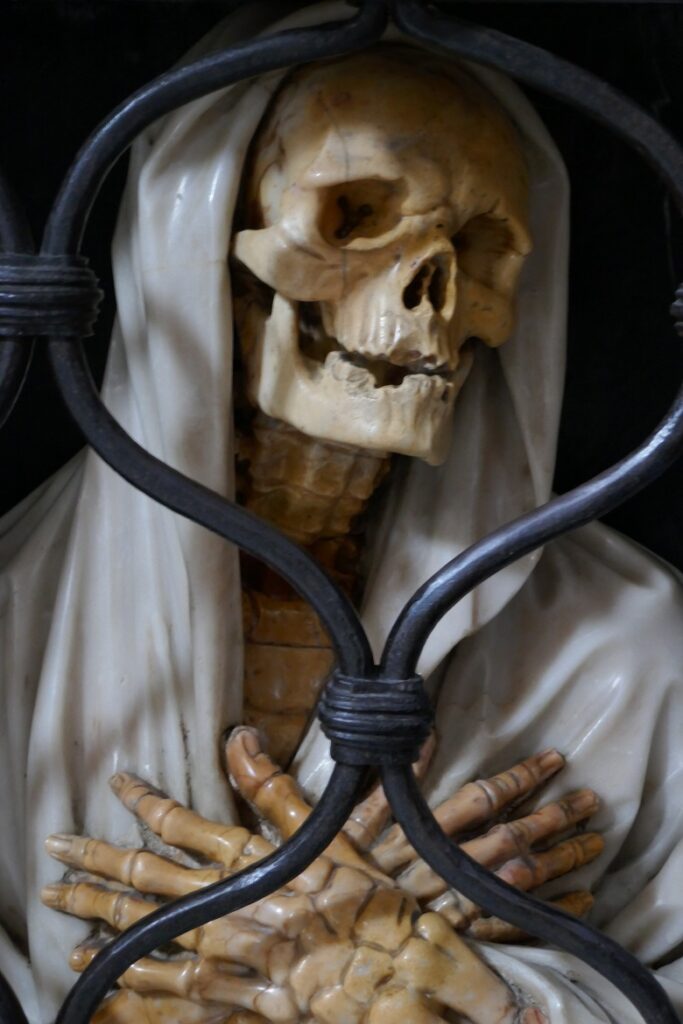
There are three main roads leading off of this piazza and at the south end you will find two impressive churches that are almost identical. These ‘twin’ churches were built onto different sized allotments between the previously established streets.
Santa Maria in Montesanto, on the east, has an oval plan and dome, while Santa Maria dei Miracoli, on the narrower allotment on the west, has a round dome.
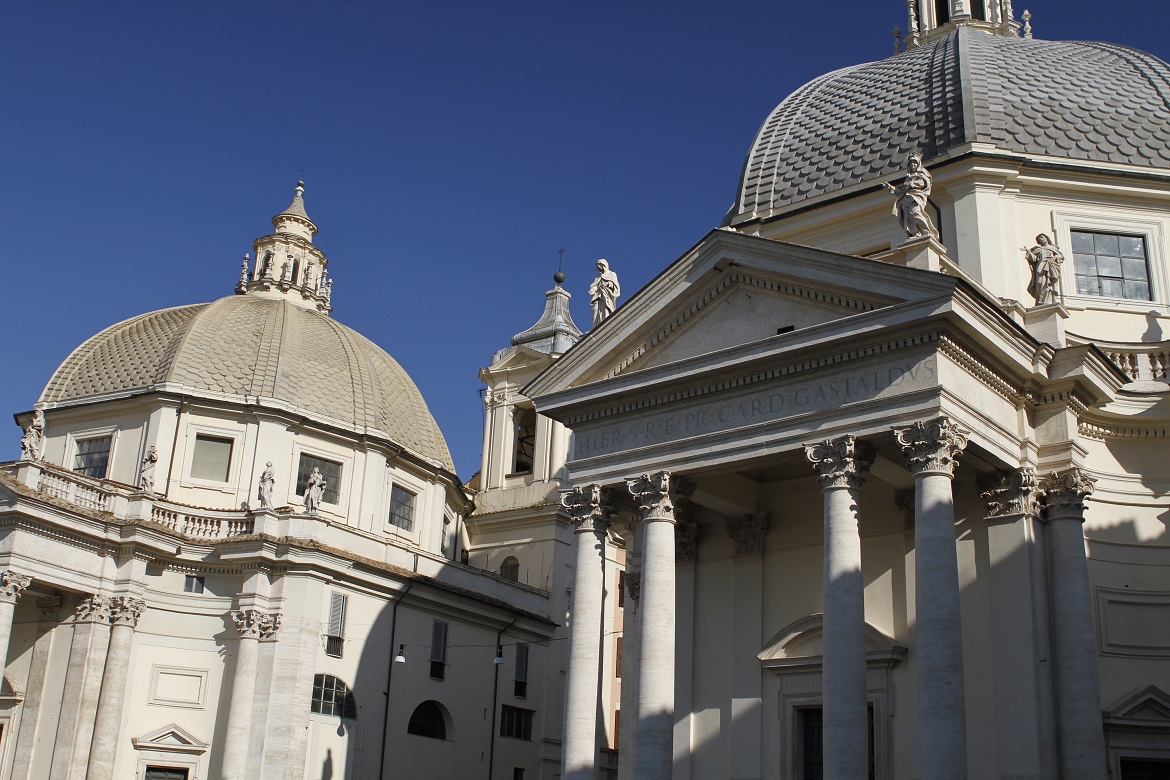
At the very centre of the piazza, you will find an Egyptian obelisk, called Flaminio Obelisk, that is bordered by fountains. This Obelisk is dedicated to Egypt’s Ramesses II.

If you want to get an impressive view of the piazza, and still have the energy, climb the stairs located on the east side of the piazza, to Pincio Park. It’s worth the effort. On your way, you will see the Pincio Gardens’ Fontana della Dea Roma (Fountain of the Goddess Roma).
So, as you can see, there is much to admire in this enormous piazza.
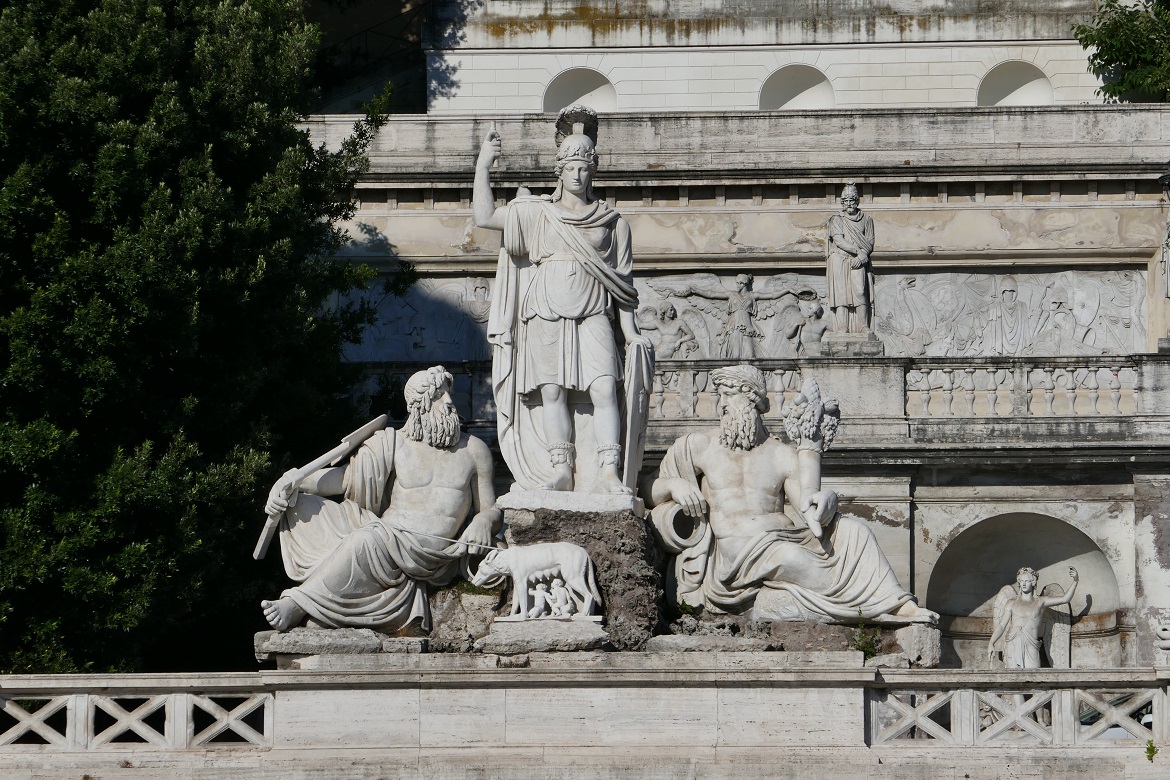
Piazza di Spagna
790 metres – 9 minutes from Piazza del Popolo
The Piazza di Spagna is located at the foot of the Pincio Hill. One of Rome’s most well-known piazzas, it is a popular place for tourists and locals to meet, relax, and linger while taking in the scenery as artists, performers and street vendors go about their daily business at the foot of the steps.
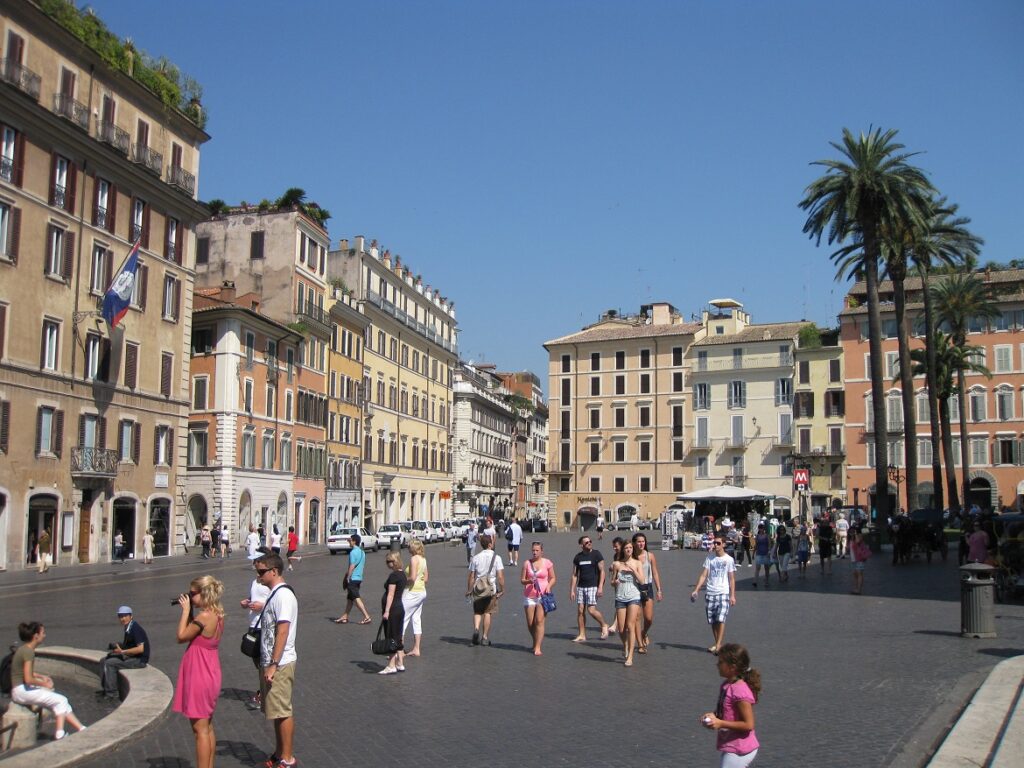
The triangular piazza, rather than square, features the baroque style Fontana della Barcaccia (Fountain of the Old Boat), designed by Pietro Bernini and his son, Gian Lorenzo Bernini. A flood that deposited a boat in the middle of the piazza inspired the sculpture, which is shaped like a sinking boat.
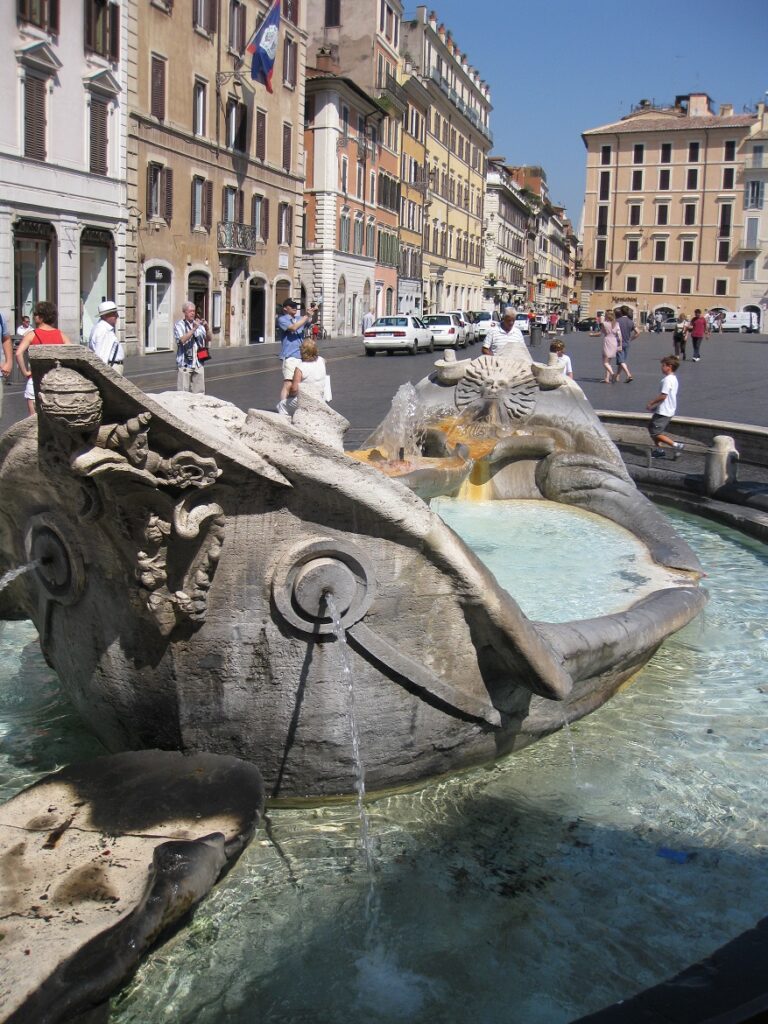
The Keats-Shelley House, which is now a museum, is situated at the bottom right of the Spanish Steps. It is devoted to English Romantic poets, many of whom visited or resided in Rome in the early nineteenth century.
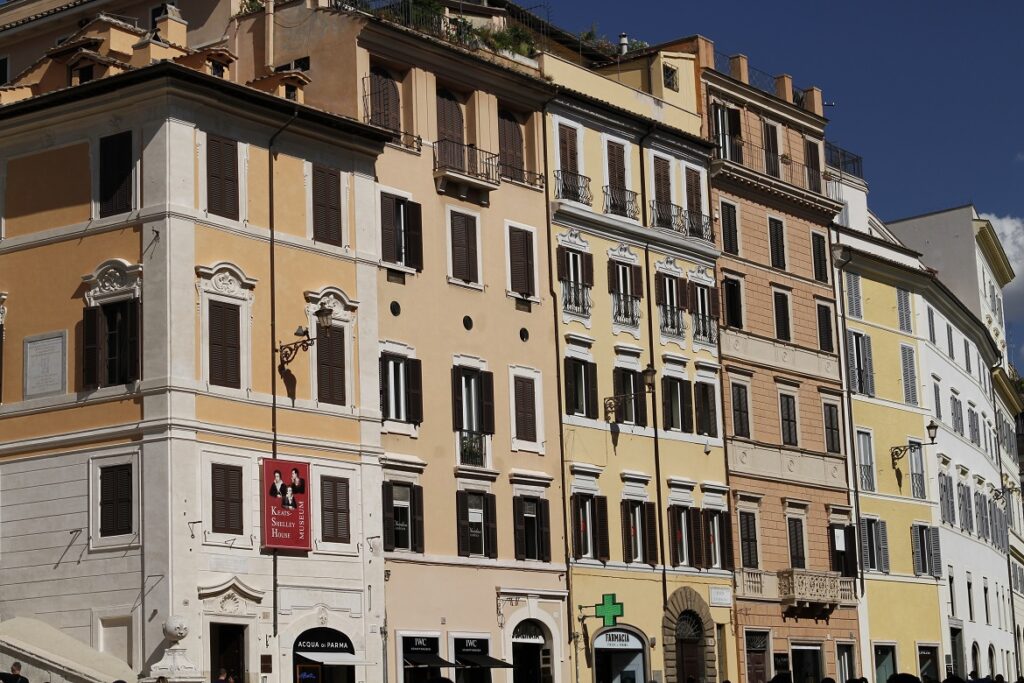
The renowned Spanish Steps rise from the base of the piazza. To get to the Gothic-style church, Chiesa di Trinità dei Monti, there are 135 steps and three separate terraces that represent the Trinità (the Holy Trinity). The Piazza della Trinità dei Monti is the name of this location.
In front of the church is the Sallustiano Obelisk. The red granite obelisk stands 13.9 metres tall, with a total height of 30.48 metres when you include the pedestal. The Sallustiano Obelisk is actually a replica of the Flaminio Obelisk, located in the Piazza del Popolo.

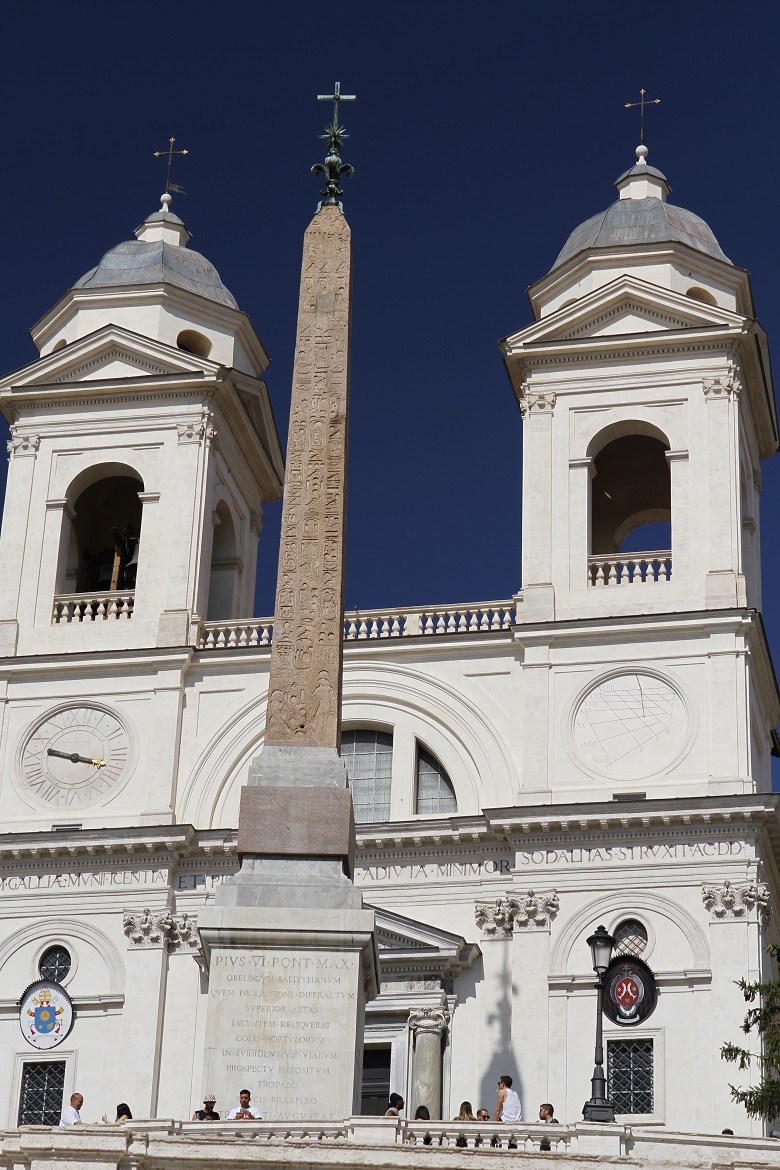
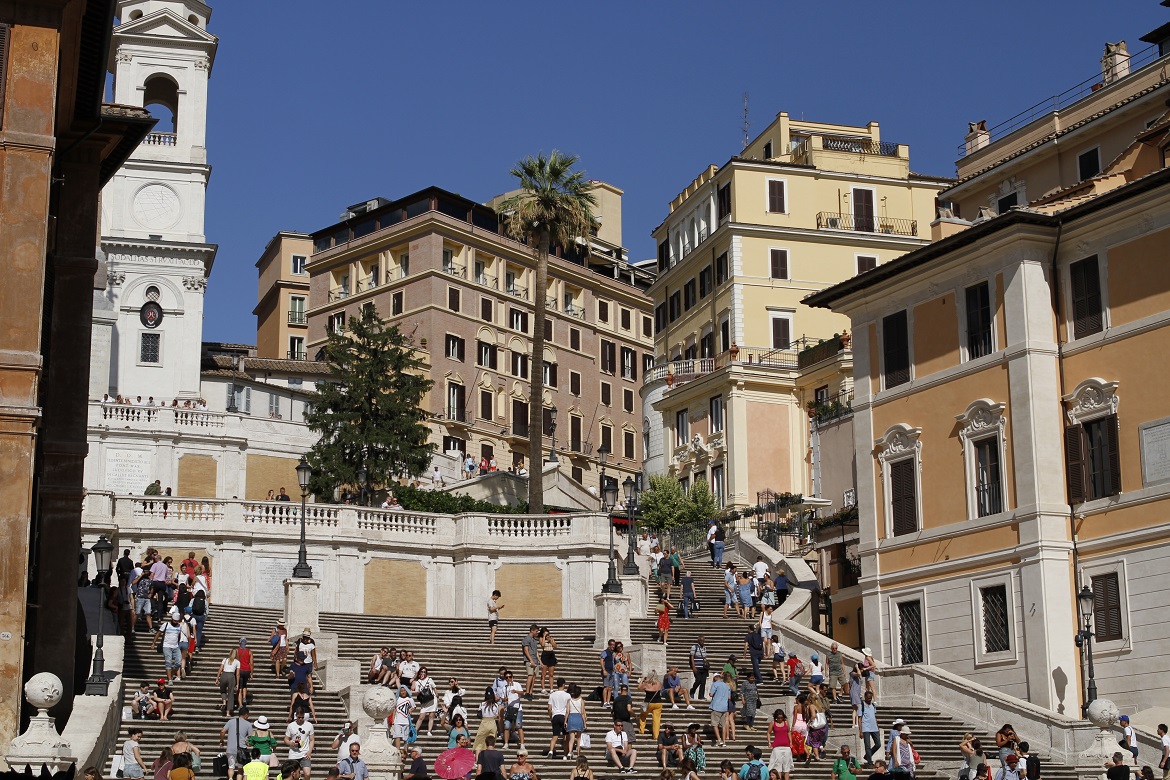
Once at the top, near the obelisk, the view of the Piazza di Spagna below is breathtaking. There is however, one disadvantage – you must share it with crowds of other tourists. The views alone are worth the effort!!
Be warned! While you can still climb and descend the stairs, sitting on them is no longer permitted as of 2019 and doing so could result in fines.
To Sum up…
This was only a small selection of the many piazzas in Rome. You can visit all of the ones I’ve highlighted here with a good pair of walking shoes, some water, and sunscreen. And if you want to find out more about Rome’s landmarks, read Our Top Five Sights in Rome story.
We think a tour of Rome’s piazzas is an excellent way to immerse yourself in Italian culture.
There are numerous cafés and gelaterie (shops selling the Italian style ice cream – gelato) around each piazza where you can enjoy an aperitif, coffee, pizza, and much more. Of course, there are numerous overpriced tourist traps as well, so beware.
The surrounding area of Piazza di Spagna has many high-end boutiques, making it ideal for shopping.
There is a Metro train station, ‘Spagna’, at the base of the Spanish Steps, making it very easy to get there and move around Rome.
Please note that distances and times calculated here is purely a guide only.
Enjoy, we certainly did!
A – Piazza di Trevi, B – Piazza della Rotonda, C – Piazza Navona, D – Piazza del Popolo, E – Piazza di Spagna
